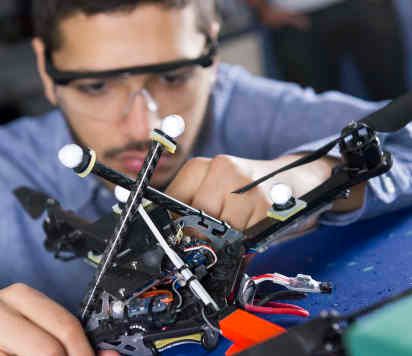
Turbulence
Overview
Virtually all of the research is fundamental in nature, aiming to unravel generic turbulence mechanisms in response to a range of forcing scenarios, and often involving mutually supportive theory, experiments and computational simulations (DNS, LES).
A major focus of research on multi‐scale interactions in turbulence effort is on the physics of non‐equilibrium turbulence. This originated from fractal/multiscale‐generated turbulence, which led to the discovery of a new dissipation law for nonequilibrium turbulence that does not involve the classical cascade concept.
Practical aspects of this fundamental research include the quantification of enhanced mixing and reduced noise behind obstacles containing fractal apertures. Fundamental investigations of the structural and statistical properties of near‐wall turbulence and its response to various forcing scenarios constitute a second major pillar of the turbulence research in the Department.
Funding
Approximately £8.5M research income from EPSRC, EU and industry (e.g. Airbus and EADS).
Staff
Emeritus Professor Peter W Bearman FREng
Emeritus Professor Peter W Bearman FREng
Emeritus Professor in Aeronautics
Dr Paul Bruce
Dr Paul Bruce
Reader in High-Speed Aerodynamics
Professor Sergei I Chernyshenko
Professor Sergei I Chernyshenko
Chair in Aerodynamics
Professor Michael Graham FREng
Professor Michael Graham FREng
Professor
Professor Yongyun Hwang
Professor Yongyun Hwang
Professor of Fluid Mechanics
Emeritus Professor Michael A Leschziner FREng
Emeritus Professor Michael A Leschziner FREng
Emeritus Professor
Professor Jonathan F Morrison
Professor Jonathan F Morrison
Professor of Experimental Fluid Mechanics
Professor George Papadakis
Professor George Papadakis
Professor of Aerodynamics
Dr Georgios Rigas
Dr Georgios Rigas
Reader in Fluid Mechanics
Professor Spencer J Sherwin FREng
Professor Spencer J Sherwin FREng
Head of the Department of Aeronautics
Professor John Christos Vassilicos
Professor John Christos Vassilicos
Visiting Professor
Flow control
Overview
Fluid flow is ubiquitous in many systems and improving their efficiency can lead to significant societal benefits. The efficiency of a fluid-based system can be viewed in a number of ways, such as the energy used to overcome resistance or the effectiveness with which a contaminant is dispersed. The former is especially important in the transport sector where reducing both energy costs and carbon emissions is essential. “Control” is used in its broadest sense: at its simplest, this is involves the passive amelioration of a fluid flow, where control is achieved by the insightful use of boundary conditions without an external energy source. On the other hand, active control involves the supply of energy for actuation that is additional to that required to maintain the flow. Therefore the efficiency of an active system has to include energy expenditure for actuation. While research challenges are multi-sectoral, the research fundamentally involves the identification and manipulation of inherent instabilities.
Funding
Aeronautics co-hosts the £4.2 M (Aero £1.1 M) Programme grant on laminar flow control (LFC-UK) studying the growth of instabilities, primarily on wing geometries, to improve numerical predictions for design. ERC Starting Grant ACOULOMODE £1.2 M, £3.4 M Marie Curie doctoral programme, MULTISOLVE, exploiting fractal apertures to enhance mixing and reduce noise.
Staff
Emeritus Professor Peter W Bearman FREng
Emeritus Professor Peter W Bearman FREng
Emeritus Professor in Aeronautics
Dr Paul Bruce
Dr Paul Bruce
Reader in High-Speed Aerodynamics
Professor Sergei I Chernyshenko
Professor Sergei I Chernyshenko
Chair in Aerodynamics
Professor Michael Graham FREng
Professor Michael Graham FREng
Professor
Professor Yongyun Hwang
Professor Yongyun Hwang
Professor of Fluid Mechanics
Emeritus Professor Michael A Leschziner FREng
Emeritus Professor Michael A Leschziner FREng
Emeritus Professor
Professor Jonathan F Morrison
Professor Jonathan F Morrison
Professor of Experimental Fluid Mechanics
Professor Rafael Palacios
Professor Rafael Palacios
Professor in Computational Aeroelasticity
Professor George Papadakis
Professor George Papadakis
Professor of Aerodynamics
Dr Georgios Rigas
Dr Georgios Rigas
Reader in Fluid Mechanics
Professor Matthew Santer
Professor Matthew Santer
Professor of Aerospace Structures
Professor Spencer J Sherwin FREng
Professor Spencer J Sherwin FREng
Head of the Department of Aeronautics
Professor John Christos Vassilicos
Professor John Christos Vassilicos
Visiting Professor
Dr Andrew Wynn
Dr Andrew Wynn
Reader in Control and Optimization
Biological fluid mechanics
Overview
The Aeronautics Department has long been involved in research into Biomedical Fluid Mechanics. The study of flows in the cardiovascular and respiratory systems are the two major themes, with a more recent interest in electrophysiology. The research is predominantly aimed at understanding how the complexities of anatomical form and flow affect physiological function in normal and pathological cases, particularly in order to provide a rational basis for clinical decision making and intervention.
Recent noteworthy innovations by the researchers include the introduction of continuous high speed PIV imaging combined with direct numerical simulation in virtual and physical replica models. The group works in close collaboration with clinicians, physiologist and biologist promoting interdisciplinary research using in-vivo, in-vitro and in-silico techniques with state of the art medical imaging.
Facilities
Access to MRI, CT and micro-CT facilities and rapid prototyping/3D printing. Computing resources include access to Imperial College HPC facilities including CX1 and CX2. In addition we have access to UK HPC facilities, including Hector and Emerald.
Funding
A number of staff involved hold prestigious grants including a BHF Advanced Training Fellowship, a Marie-Curie career integration fellowship and a Royal Academy of Engineering Research Chair. Staff are also closely involved in the Imperial College British Heart Foundation Centre of Research Excellence.
Staff
Professor Denis J Doorly
Professor Denis J Doorly
Professor of Fluid Mechanics
Professor Yongyun Hwang
Professor Yongyun Hwang
Professor of Fluid Mechanics
Professor Spencer J Sherwin FREng
Professor Spencer J Sherwin FREng
Head of the Department of Aeronautics
Professor Peter E Vincent
Professor Peter E Vincent
Professor of Computational Fluid Dynamics


